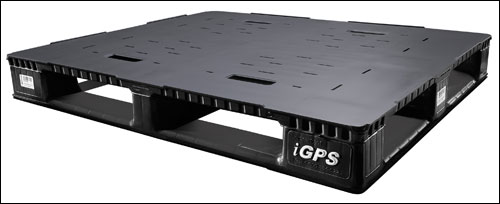Mar 05, 2012As the use of plastic for such products as pallets, trays and containers continues to grow—replacing heavier and more destructible wood—some thieves have taken the opportunity to steal these goods, in order to grind the plastic down and sell it to recyclers. But iGPS, a company that provides plastic pallets to its customers on a rental basis, has found a way to address this problem. Over the past few months, says Al Farrell, iGPS' VP of asset management, law-enforcement authorities—with help from the company's track-and-trace system—have apprehended several such plastic grinders in Ohio, Virginia, California and Arizona.
The solution utilizes the Spider AT tag, a battery-powered wireless asset tag from Novatel Wireless' Enfora division, which iGPS has incorporated into some of its pallets. The Spider AT tag, which contains a GPS unit, transmits its ID number and location via a cellular connection; iGPS is using the tag in conjunction with the EPC Gen 2 passive ultrahigh-frequency (UHF) RFID tags that it embeds into all of its pallets, in order to uniquely identify each pallet. The company is employing Numerex Corp.'s WorldPass Network Service software to manage data received from the Spider AT tags' transmissions.
Each iGPS pallet has four identical EPC Gen 2 RFID tags internally embedded, one in each corner (see Growers and Grocers Get Into Plastic Pallet Pool). That same unique ID number is also printed on all four sides of the pallet, both in the form of a bar code and as alphanumeric text. The company has millions of pallets moving through supply chains across the United States, each of which is expected to be returned to iGPS' pallet pool for reuse by other customers. Many pallets can end up missing in the process, though Farrell declines to specify the number lost annually. All of iGPS' customers use a handheld RFID or bar-code reader to identify the pallets they ship to a distribution center or retailer, after loading them with products. That unique identifier is stored in software provided by iGPS, along with shipping information input by users, such as the pallet's destination. This data is then automatically forwarded to the pallet company. The unique ID read or scanned by a particular customer, along with a timestamp for that event, provides iGPS with greater visibility into when that customer sends the pallets to another location. The passive RFID technology, however, has its limitations: In the event that a pallet leaves the expected supply chain route, it becomes difficult to trace where that occurred, and where the pallet has gone.
The Enfora Spider AT tag is intended to help the company fill in the blanks between RFID tag reads. The company has installed the Spider inside some of its pallets, Farrell says, so that the tag are not visible, and programs them to transmit a message on a regular basis, via a GPRS cellular network. Every time a Spider AT tag sends out a transmission, it includes the longitude and latitude of its location, based on the GPS readings. That transmission is received by the WorldPass Network Service software, which operates on the Numerex server, and is then forwarded to iGPS' database, where Spider software—developed jointly by iGPS and Enfora—analyzes location data for each pallet, issuing alerts when necessary.
The WorldPass software can also determine when a group of pallets has dwelled at one location for an excessive length of time. IGPS' staff then have the option of either contacting the operator who has custody of those pallets (based on the GPS data and the RFID records or receipt), or simply storing that information in order to better understand the supply chains, as well as where bottlenecks may occur.
The pallet company first began embedding the Spider AT tags in some of its pallets approximately a year and a half ago. By using passive EPC RFID tags, in conjunction with Enfora's GPS/GPRS battery-powered tags, Farrell says, iGPS has "found a lot of value in tracking and tracing our assets. It helps us determine our points of attrition, and helps us have a more controlled network."
As the company installed the Spider devices in more of its pallets, Farrell reports, it has become more successful at locating missing pallets and retrieving them before they could be destroyed. The apprehension of thieves and the retrieval of missing pallets, he adds, has saved the pallet provider more money than it spent on the technology itself.
The company is now testing Intelleflex battery-assisted passive UHF RFID tags with built-in temperature sensors on some of its pallets. It intends to provide RFID tags equipped with temperature or shock sensors, in addition to the existing EPC Gen 2 passive UHF RFID tags, for customers that may request the technology (such as those shipping fresh produce or shock-sensitive products.) At present, some customers are utilizing the pallets' built-in EPC Gen 2 RFID tags to track their own shipments of product from warehouses to stores. According to Farrell, a trend toward the use of laser-guided, unmanned vehicles—that move products around a facility, or into and out of trucks—makes radio frequency identification technology more desirable. Some of these vehicles have built-in readers that interrogate the identifier on the loaded pallets, enabling a customer to associate an event (such as loading a truck) with a specific pallet's ID number and the products loaded onto it.


